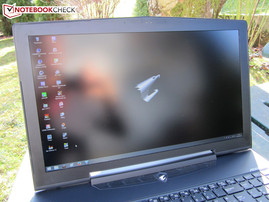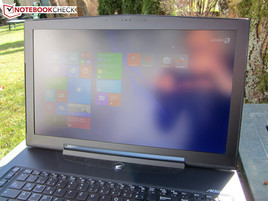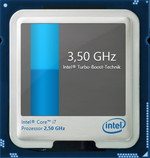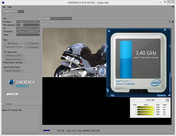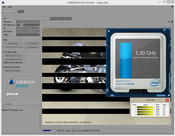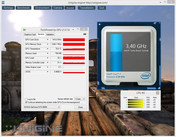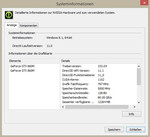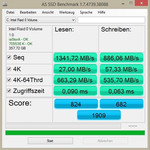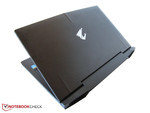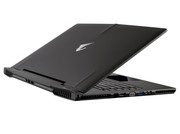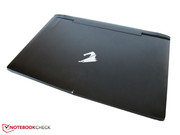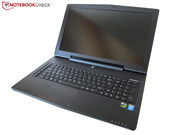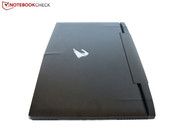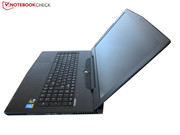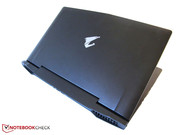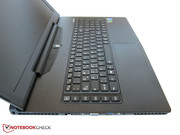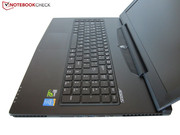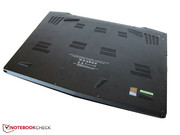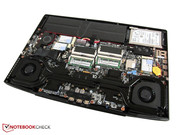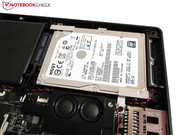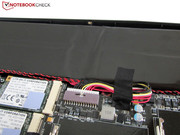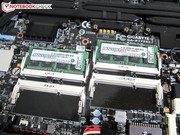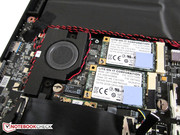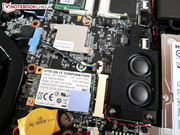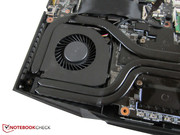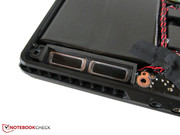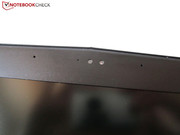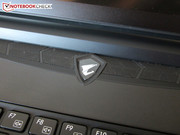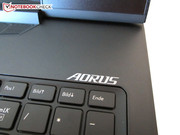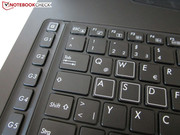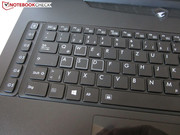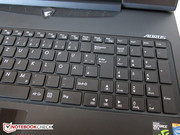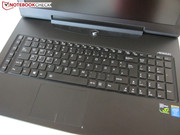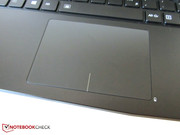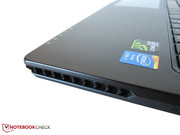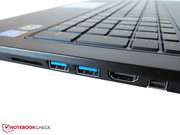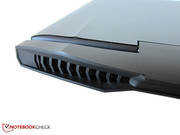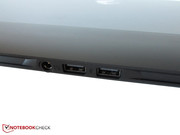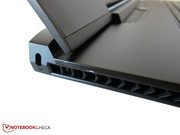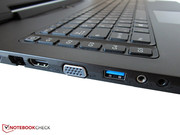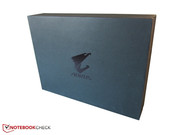Aorus X7 v2 Notebook Review Update
For the original German review, see here.
While most manufacturers make do with one dedicated graphics card, Aorus even packs two Nvidia chips in its high-end product. But the X7 v2's graphics solution is not the only difference to the competition. It is also different in other aspects, for example, the hard drive setup: While the predecessor came with two mSATA-SSDs in RAID-0, the new model impresses even more with three mSATA-SSDs.
Apart from mass storage, the processor was optimized. Aorus replaced the Core i7-4700HQ with the slightly faster Core i7-4710HQ (according to the homepage a Core i7-4860HQ is planned). The RAM-type also makes the laptop stand out: Only a few companies use DDR3-1866 (previously: DDR3-1600).
Apart from that, Aorus did not change the design. The 17-inch case weighs still about 3.2 kg (~7 pounds) and is only 2.3 cm (~0.9 inches) high. The display is still a matte TN panel. Learn about the Macro keys, build quality and input devices in this review. We skipped several sections here, since they are very similar and will start directly with the display section.
Display
The display is a mixed bag. On the one hand, we can say that the multimedia capabilities of the AU Optronics B173HW02 V1 are good. Images have vivid colors and appear to be contrast-rich - subjectively, at least. However, it is not outstanding according to our measurements.
First of all the brightness is only mid-range with an average of 260 cd/m² (despite being the same panel, the previous test model was 8% brighter). Although reflections are very rare thanks to the matte surface, many customers might still wish for more brightness when they use the laptop outdoors.
| |||||||||||||||||||||||||
Brightness Distribution: 83 %
Center on Battery: 284 cd/m²
Contrast: 498:1 (Black: 0.57 cd/m²)
ΔE ColorChecker Calman: 10.29 | ∀{0.5-29.43 Ø4.78}
ΔE Greyscale Calman: 11.28 | ∀{0.09-98 Ø5}
58% AdobeRGB 1998 (Argyll 1.6.3 3D)
65% AdobeRGB 1998 (Argyll 3D)
88.9% sRGB (Argyll 3D)
66.6% Display P3 (Argyll 3D)
Gamma: 2.27
CCT: 12579 K
The black value of the AU Optronics B173HW02 V1 is also second-rate. Just under 0.6 cd/m² is rather disappointing in view of the laptop's price of 2000 Euros (~$2687). Dark scenes in games and videos look slightly grayish. Nevertheless, the image quality is better than run-of-the-mill screens'.
The contrast is 500:1, which is about on par with the predecessor's. Other 17-inch displays, for example the popular Chi Mei N173HGE, achieve contrast ratios between 800 and 1000:1 (MSI GS70/GT70, Clevo P170SM-A, Clevo P177SM-A...). However, the latter suffers from a grainy finish.
The color rendering of the Aorus X7 v2 is also a point of criticism. Our CalMAN screenshots show that many values (grayscale, saturation, color precision...) sometimes deviate significantly from the ideal values (the same is true for the Chi Mei N173HGE). This is a nuisance for professional users, but multimedia fans will hardly mind it. The competitor Asus, which also uses the AU Optronics B173HW02 V1 in its G750 series, conceals this weakness with its own color profile. The color space itself is satisfactory: 78% sRGB and 58% AdobeRGB are neither bad nor exemplary.
It is similar with the viewing angles, which are slightly better than the average of TN displays. As long as you do not flip the lid too far forwards or backwards, the image looks quite realistic. However, an IPS display is required for a top rating. Smaller gaming notebooks like the Schenker M504, the Gigabyte P34G v2 or the Asus GL550JK are more apt for image enthusiasts (IPS displays are still rare in the 17-inch range).
Performance
Processor
The processor belongs to Intel's Haswell generation. With a clock rate of 2.5 to 3.5 GHz the quad-core CPU clocks 100 MHz faster than the Core i7-4700HQ, which is also directly connected to the mainboard, and so, (other than MQ models) not replaceable. The other features are identical. With six MB L3 cache and 1.4 billion transistors, the Core i7-4710HQ is definitely top-rate.
We look critically at the waste heat. Although the Haswell architecture is produced in 22 nm lithography, quad-core chips get rather hot. A TDP of 47 Watts is not exactly low. We especially regret that the SLI array prevents graphics switching. With the Optimus technology (either the Intel or the Nvidia chip is used for graphics calculations) the battery life would be longer. In the Aorus X7 v2 the HD Graphics 4600 remains inactive.
Turbo Boost
In realistic scenarios, the CPU easily overclocks. Regardless of single core or multi-core load, the quad-core CPU clocks between 3.3 to 3.5 GHz, which is more than respectable for a laptop. Although we observed massive throttling to 1.1 to 1.4 GHz during our stress test with FurMark and Prime95, the results in our application and gaming benchmarks do not hint of throttling in real-world applications.
CPU Performance
The 22 nm Core i7-4710HQ performs very well in the Cinebench R15 benchmarks thanks to the Hyperthreading technology, which simulates four virtual cores. With 659 points, the 17-incher is only marginally slower than the One K73-4N, which was powered by a Core i7-4800MQ in our review (663 points). It even did not fall too far behind the Core i7-4810MQ (680 points @ Schenker XMG P724). Meanwhile, the weaker brothers, the Core i7-4700HQ (633 points @ Aorus X7 v1) and the Core i7-4700MQ (623 points @ Nexoc G728II) are just under 5% slower.
The Multi-CPU test did not bring any surprises: 136 points remind us of the result of the predecessor. The Core i7-4800MQ or the Core i7-4810MQ does not pay off for most users. An advantage of 5 to 7% is virtually irrelevant in practice.
| Cinebench R15 | |
| CPU Single 64Bit (sort by value) | |
| Core i7-4710HQ | |
| Core i7-4700HQ | |
| Core i7-4700MQ | |
| Core i7-4800MQ | |
| Core i7-4810MQ | |
| CPU Multi 64Bit (sort by value) | |
| Core i7-4710HQ | |
| Core i7-4700HQ | |
| Core i7-4700MQ | |
| Core i7-4800MQ | |
| Core i7-4810MQ | |
| Cinebench R11.5 | |
| CPU Single 64Bit (sort by value) | |
| Core i7-4710HQ | |
| Core i7-4700HQ | |
| Core i7-4700MQ | |
| Core i7-4800MQ | |
| Core i7-4810MQ | |
| CPU Multi 64Bit (sort by value) | |
| Core i7-4710HQ | |
| Core i7-4700HQ | |
| Core i7-4700MQ | |
| Core i7-4800MQ | |
| Core i7-4810MQ | |
Graphics Card
The graphics card is one of the biggest changes. The manufacturer upgraded from the GTX 765M to the brand new GTX 860M. Actually, “brand new” is only an adequate word for the Maxwell model of the DirectX 11 chip. Unlike most laptop companies, Aorus uses the Kepler edition, which is 10% slower. While it features more shader units (1,152 vs. 640), it has to make do with an old architecture and slower clock rates. Instead of 1029 to 1097 MHz the Kepler model only clocks at 797 to 915 MHz.
The memory clock of the 4096 MB GDDR5 VRAM is 2500 MHz, each. Due to the small interfaces (128-bit) the GTX 860M hardly profits from the big memory. At least, the clock rates are maintained in extreme situations. The test device continued to run at its full GPU Turbo speed after one hour of full load.
An important unique feature of the Aorus X7 is its dual GPU configuration. As with the AMD counterpart called CrossFire, SLI also has disadvantages. Apart from higher power consumption, the enormous cooling requirement has to be mentioned here. Dual GPU notebooks are known to get rather loud and warm. Furthermore, they suffer from so-called micro stuttering. Due to varying intervals, the image could appear jerkier than with a single GPU despite better frame rates. In our review, we faced this problem in Far Cry 3 for example. While an average frame rate of 38 fps with maximum settings (Ultra, DX11, 4x MSAA) sounds decent, the game could not be enjoyed.
Another weakness is that multi GPU systems are driver dependent. If the system lacks a compatible SLI profile, the second graphics card is not advantageous and might even have a negative impact on performance. So, it is all the more annoying that none of the official Nvidia driver works on the Aorus X7 v2 so far (tried ForceWare 337.88 WHQL and 340.43 Beta). Although we replaced the preinstalled driver with a newer version downloaded from Aorus' homepage (333.11 instead of 333.04), the performance was rather poor in current games. Aorus has to optimize the driver support for games like GRID: Autosport, Watch Dogs and Wolfenstein: The New Order to run well. Those who do not want to constantly bother about driver updates should buy a standard laptop.
GPU Performance
The X7 v2 exhibits excellent performance in the synthetic graphics benchmarks. The Radeon R9 M290X (5294 points @ One K56-4N) as well as the GeForce GTX 870M (4664 points @ One K73-4N) are far from achieving 5941 points in the Fire-Strike test of 3DMark 13. With this result, the SLI combo is on a level with the GTX 880M, which achieved just above 6000 points (Schenker XMG P704). Without the support of its twin the GTX 860M is about 50% slower (3174 points @ Schenker W504). The X7 v1 only achieved 4795 points, which is 19% less.
In Unigine Heaven 3.0, the differences are similarly noticeable. With 82.8 fps, the 17-incher is 2% faster than GTX 880M notebooks (81.2 fps) and 27% faster than GTX 870M laptops (65 fps). The Radeon R9 M290X performs just under a third worse (62 fps). With deactivated SLI, the system would achieve about 45 fps (~50 fps @Maxwell). All results considered, the Aorus X7 v2 is a high-end machine.
| Unigine Heaven 3.0 - 1920x1080 DX 11, Normal Tessellation, High Shaders AA:Off AF:Off (sort by value) | |
| GeForce GTX 860M SLI (333.11) | |
| GeForce GTX 765M SLI (332.28) | |
| GeForce GTX 860M Kepler (332.35) | |
| GeForce GTX 860M Maxwell (332.60) | |
| AMD Radeon R9 M290X (13.151.0.0) | |
| GeForce GTX 870M (332.35) | |
| GeForce GTX 880M (332.35) | |
| 3DMark Vantage P Result | 27223 points | |
| 3DMark 11 Performance | 8867 points | |
| 3DMark Ice Storm Standard Score | 131117 points | |
| 3DMark Cloud Gate Standard Score | 19048 points | |
| 3DMark Fire Strike Score | 4717 points | |
Help | ||
Storage Devices
In mass storage, it even reached first place of all laptops we have reviewed so far. The RAID-0 connection of three LiteOn LMT-128M6M mSATA-SSDs does not only score points with good total capacity (384 GB), but also with excellent performance. 886 MB/s in the sequential write test of the AS SSD benchmark is just as tremendous at 1342 MB/s in the read test. By comparison, a single SSD cannot achieve more than 500 MB/s.
However, you will not usually notice the difference. Performance when opening files, installing or booting is the same without RAID since the triple SSD system cannot achieve new top values in the 4K tests. Regardless of the number of SSD drives, the access time is impressive. 0.09 ms and 0.063 ms, respectively, meet the premium claim.
In case free memory gets low after all, Aorus also incorporated a 1000 GB 2.5 inch HDD. The HGST Travelstar 7K1000 meets all expectations with up to 142 MB/s (CrystalDiskMark).
System Performance
PCMark 7 makes apparent that the system is balanced: 5917 points are a pipe dream for most notebooks. Apart from the Asus G750JZ-T4023H and the MSI GS70-2PEi71611, the Aorus also outperforms our test model of the Alienware 17 (between 5400 and 5800 points).
| PCMark 7 Score | 5917 points | |
| PCMark 8 Home Score Accelerated v2 | 4046 points | |
| PCMark 8 Creative Score Accelerated v2 | 4136 points | |
| PCMark 8 Work Score Accelerated v2 | 4731 points | |
Help | ||
Gaming Performance
If you do not consider games, which do not (yet) have a dual GPU profile, the SLI connection is about as fast as a GTX 880M. Apart from Crysis 3, which runs just under 17% faster on Nvidia's top model (1920x1080, very high, 2x SMAA), the maximum performance difference is 9%. Compared directly, the GeForce GTX 870M does not stand a chance and is about 20% slower. The difference to the X7 v1 is slightly lower: +16% for the successor.
Graphics Card |
Total performance @Ultra-Setting |
|---|---|
GeForce GTX 860M SLI |
Basis (only games with SLI profile) |
GeForce GTX 880M |
+/-0% |
GeForce GTX 765M SLI |
-14% |
GeForce GTX 870M |
-19% |
GeForce GTX 860M |
-44% |
A look at the single GTX 860M shows that Nvidia is capable of developing good drivers. Upon activating the second GPU, the performance increases by 80% on average. Apart from a few exceptions (Crysis 3, Watch Dogs), the Aorus X7 v2 can run all games with maximum details. There are even enough reserves for anti-aliasing. Currently, only SLI combos of GTX 870M or GTX 880M are faster.
| GRID: Autosport - 1920x1080 Ultra Preset AA:4x MS (sort by value) | |
| GeForce GTX 860M SLI (333.11) | |
| GeForce GTX 860M Kepler (337.88/340.43) | |
| GeForce GTX 870M (337.88/340.43) | |
| GeForce GTX 880M (337.88/340.43) | |
| Watch Dogs - 1920x1080 Ultra Overall Quality, Ultra Textures AA:4x MS (sort by value) | |
| GeForce GTX 860M SLI (333.11) | |
| GeForce GTX 860M Kepler (337.88/340.43) | |
| GeForce GTX 870M (337.88/340.43) | |
| GeForce GTX 880M (337.88/340.43) | |
| Wolfenstein: The New Order - 1920x1080 Ultra Preset (sort by value) | |
| GeForce GTX 860M SLI (333.11) | |
| GeForce GTX 860M Kepler (337.88/340.43) | |
| GeForce GTX 870M (337.88/340.43) | |
| GeForce GTX 880M (337.88/340.43) | |
| Thief - 1920x1080 Very High Preset AA:FXAA & High SS AF:8x (sort by value) | |
| GeForce GTX 860M SLI (333.11) | |
| GeForce GTX 860M Kepler (332.35) | |
| GeForce GTX 870M (332.35) | |
| GeForce GTX 880M (332.35) | |
| Call of Duty: Ghosts - 1920x1080 Extra / High / HBAO+ / No dynamic fur AA:4x MS (sort by value) | |
| GeForce GTX 860M SLI (333.11) | |
| GeForce GTX 765M SLI (332.28) | |
| GeForce GTX 860M Kepler (332.35) | |
| GeForce GTX 870M (332.35) | |
| GeForce GTX 880M (332.35) | |
| Battlefield 4 - 1920x1080 Ultra Preset AA:4x MS (sort by value) | |
| GeForce GTX 860M SLI (333.11) | |
| GeForce GTX 765M SLI (332.28) | |
| GeForce GTX 860M Kepler (332.35) | |
| GeForce GTX 870M (332.35) | |
| GeForce GTX 880M (332.35) | |
| Saints Row IV - 1920x1080 Ultra Preset AA:8x MS AF:16x (sort by value) | |
| GeForce GTX 860M SLI (333.11) | |
| GeForce GTX 765M SLI (332.28) | |
| GeForce GTX 860M Kepler (332.35) | |
| GeForce GTX 870M (332.35) | |
| GeForce GTX 880M (332.35) | |
| Dota 2 - 1920x1080 High / On, Render Quality: 100 % (sort by value) | |
| GeForce GTX 860M SLI (333.11) | |
| GeForce GTX 765M SLI (332.28) | |
| GeForce GTX 860M Kepler (332.35) | |
| GeForce GTX 870M (332.35) | |
| GeForce GTX 880M (332.35) | |
| GRID 2 - 1920x1080 Ultra Preset AA:4xMS (sort by value) | |
| GeForce GTX 860M SLI (333.11) | |
| GeForce GTX 765M SLI (332.28) | |
| GeForce GTX 860M Kepler (332.35) | |
| GeForce GTX 870M (332.35) | |
| GeForce GTX 880M (332.35) | |
| Metro: Last Light - 1920x1080 Very High (DX11) AF:16x (sort by value) | |
| GeForce GTX 860M SLI (333.11) | |
| GeForce GTX 765M SLI (332.28) | |
| GeForce GTX 860M Kepler (332.35) | |
| GeForce GTX 870M (332.35) | |
| GeForce GTX 880M (332.35) | |
| BioShock Infinite - 1920x1080 Ultra Preset, DX11 (DDOF) (sort by value) | |
| GeForce GTX 860M SLI (333.11) | |
| GeForce GTX 765M SLI (332.28) | |
| GeForce GTX 860M Kepler (332.35) | |
| GeForce GTX 870M (332.35) | |
| GeForce GTX 880M (332.35) | |
| Tomb Raider - 1920x1080 Ultra Preset AA:FX AF:16x (sort by value) | |
| GeForce GTX 860M SLI (333.11) | |
| GeForce GTX 765M SLI (332.28) | |
| GeForce GTX 860M Kepler (332.35) | |
| GeForce GTX 870M (332.35) | |
| GeForce GTX 880M (332.35) | |
| Crysis 3 - 1920x1080 Very High Preset AA:2xSM AF:16x (sort by value) | |
| GeForce GTX 860M SLI (333.11) | |
| GeForce GTX 765M SLI (332.28) | |
| GeForce GTX 860M Kepler (332.35) | |
| GeForce GTX 870M (332.35) | |
| GeForce GTX 880M (332.35) | |
| Far Cry 3 - 1920x1080 DX11 Ultra Preset (HDAO, Enhanced Alpha To Coverage) AA:4x MS (sort by value) | |
| GeForce GTX 860M SLI (333.11) | |
| GeForce GTX 765M SLI (332.28) | |
| GeForce GTX 860M Kepler (332.35) | |
| GeForce GTX 870M (332.35) | |
| GeForce GTX 880M (332.35) | |
| Hitman: Absolution - 1920x1080 Ultra Preset AA:4xMS AF:16x (sort by value) | |
| GeForce GTX 860M SLI (333.11) | |
| GeForce GTX 765M SLI (332.28) | |
| GeForce GTX 860M Kepler (332.35) | |
| GeForce GTX 870M (332.35) | |
| GeForce GTX 880M (332.35) | |
| Guild Wars 2 - 1920x1080 All Maximum / On AA:FX (sort by value) | |
| GeForce GTX 860M SLI (333.11) | |
| GeForce GTX 765M SLI (332.28) | |
| GeForce GTX 860M Kepler (332.35) | |
| GeForce GTX 870M (332.35) | |
| GeForce GTX 880M (332.35) | |
| low | med. | high | ultra | |
|---|---|---|---|---|
| Guild Wars 2 (2012) | 124 | 67.5 | 45.2 | |
| Hitman: Absolution (2012) | 66 | 61.4 | 53.9 | 35.8 |
| Far Cry 3 (2012) | 111 | 100.9 | 84.9 | 38.4 |
| Crysis 3 (2013) | 130.9 | 108.5 | 83.7 | 28.3 |
| Tomb Raider (2013) | 384.8 | 275.5 | 167 | 80.6 |
| BioShock Infinite (2013) | 223.4 | 185 | 162.6 | 61.8 |
| Metro: Last Light (2013) | 95.4 | 86.5 | 62 | 39.3 |
| GRID 2 (2013) | 206.7 | 149.6 | 133.9 | 81.8 |
| Dota 2 (2013) | 119 | 111.9 | 107.4 | |
| Saints Row IV (2013) | 87.8 | 74.4 | 64.2 | 55 |
| Battlefield 4 (2013) | 172.5 | 153 | 120.8 | 49.7 |
| Call of Duty: Ghosts (2013) | 102.2 | 96.8 | 73.2 | 46.3 |
| Thief (2014) | 75.5 | 67.5 | 64.2 | 40.4 |
| Wolfenstein: The New Order (2014) | 60 | 60 | 49.6 | 32.2 |
| Watch Dogs (2014) | 84.3 | 60 | 18.9 | 14.6 |
| GRID: Autosport (2014) | 253.6 | 146.1 | 68 | 33.3 |
Emissions
System Noise
Does the idea of a slim dual GPU notebook make you shake your head? Well, your worries are not completely unfounded. Although the two fans stay comfortably quiet while idling (only the HDD is audible), simple tasks like MS Office, videos or surfing are accompanied by an audible noise (~33 dB(A)). Sometimes it even increases to the 40 dB(A) range, which is quite absurd during normal Windows usage.
Under load (3D applications, games...) the X7 v2 could replace a hair dryer. While we measured 44 to 49 dB(A) in our first 3DMark sequence, the noise increased to 49 to 53 dB(A) in the second run with an average of 52.8 dB(A) (46.3 dB(A) @ X7 v1). This is even high for a gaming laptop. The recently reviewed MSI GS70 shows that other manufacturers also struggle with noise: 49.6 dB(A) is also very loud and drowns out the sound effects of many games (unless you are using a headset).
The fact remains that cooling such powerful hardware is only possible with big trade-offs. Currently, Razer is the only manufacturer who has managed to produce a fast, slim and quiet gaming notebook (Blade 14). By the way, all measurements were done with the fan setting “Auto” (can be changed via Command & Control).
Noise level
| Idle |
| 29 / 31.4 / 33 dB(A) |
| HDD |
| 32 dB(A) |
| Load |
| 52.8 / 53.2 dB(A) |
 | ||
30 dB silent 40 dB(A) audible 50 dB(A) loud |
||
min: | ||
Temperature
The Aorus X7 v2 also lost points in temperature. The case surfaces get surprisingly warm just idling. Our thermometer displayed an average of 39 °C (102.2 °F) on the top side and just less than 40 °C (104 °F) on the underside. MSI is much better in cooling its GS70 (~28 °C; 82.4 °F).
In 3D mode, the two notebooks perform quite similarly. Both reach above 50 °C (122 °F) after one hour of stress test. In some parts, the case even exceeded 60 °C (140 °F). Hence, sensitive users should steer clear of this device. Longer gaming sessions might be uncomfortable. We would also advise against gaming on the lap.
It is by no means better under the hood. Quite the contrary: Although our stress test is not necessarily a realistic scenario, a maximum of 89 °C (192.2 °F) for the SLI connection and up to 98 °C (208.4 °F) for the processor (according to the CPUID HWMonitor) does not hint of perfect cooling. The MSI GS70 performed even worse. Its Nvidia chip exceeded 90 °C (194 °F) despite throttling. Thicker high-end notebooks with more cooling space tend to perform better in this aspect (for example the Asus G750JZ).
(-) The maximum temperature on the upper side is 59.7 °C / 139 F, compared to the average of 40.4 °C / 105 F, ranging from 21.2 to 68.8 °C for the class Gaming.
(-) The bottom heats up to a maximum of 64.2 °C / 148 F, compared to the average of 43.3 °C / 110 F
(-) In idle usage, the average temperature for the upper side is 39 °C / 102 F, compared to the device average of 33.9 °C / 93 F.
(-) The palmrests and touchpad can get very hot to the touch with a maximum of 47.3 °C / 117.1 F.
(-) The average temperature of the palmrest area of similar devices was 28.9 °C / 84 F (-18.4 °C / -33.1 F).
Speakers
As far as we can tell, the sound system is identical with the predecessor's.
Energy Management
Power Consumption
With active SLI, the power consumption is significantly higher than an Optimus notebook's. While the MSI GS70-2PEi71611 needs between 6.2 and 27.3 Watts while idling, the Aorus X7 v2 takes 24.4 to 35.9 Watts. The predecessor required a similar amount of energy with 26.0 to 33.6 Watts.
The difference to the competitor from MSI is not that huge in 3DMark 06. 137.5 instead of 123.5 Watts is acceptable in view of the higher performance. With an average of 130.4 Watts, the Aorus X7 v1 comes in between the two. Good news regarding the power adapter: Although we measured up to 229 Watts at the wall socket, the 200-Watt adapter had no issues. The 180-Watt power adapter stopped working during the stress test.
| Off / Standby | |
| Idle | |
| Load |
|
Key:
min: | |
Battery Life
To start with, the first X7 model did not have an especially good battery life. 104 minutes (Classic Test @ Battery Eater) and 185 minutes (Reader's Test @ Battery) are anything but overwhelming. Due to the more powerful hardware, the X7 v2 runtimes are even less. 82 up to a maximum of 156 minutes are only sufficient for very short trips. The GS70 from MSI performs better. Thanks to its graphics switching, the 17-incher lasts up to seven hours (4 hours during WLAN surfing with medium brightness). The battery life should be longer without SLI.
Verdict
Did Aorus produce the slimmest and lightest dual GPU notebook with the X7 v2? Probably yes. However, as expected, the exciting concept also involves disadvantages like high temperatures and loud noise in 3D mode. The manufacturer should also improve the display (mediocre values) and the sound system. More quality is to be expected for a price of 2000 Euros (~$2687).
There are also smaller flaws in build quality. As with the Gigabyte P34G v2 and P35W v2, the keyboard does not attach homogeneously to the surrounding case. With a closer look, the gaps between the parts are uneven at the edges, too.
It is up to you whether you consider SLI useful. While the GTX 860M duo is sometimes faster than the GTX 880M, which could not be used in such a slim notebook anyway, it also relies on the very latest drivers. Without a compatible SLI profile, the second graphics chip does not have an effect. The high power consumption when idle and other drawbacks (micro stuttering...) will discourage many customers from buying. We are still convinced that a single graphics card is the better solution for gamers. In addition, we would like to see a matte touchpad and a smaller power adapter.
Certainly, the Aorus X7 v2 also has its advantages. The highlights include an attractive look, which is neither extravagant nor boring. Many interfaces and the backlit keyboard (macro keys with five functions each) are also pros. In general, the equipment is very extensive. By that we do not only mean the case, but especially the hardware. Three mSATA-SSDs in RAID-0: Who would have thought it a few years ago? However, it is controversial whether such a combination makes sense. The bottom line is that one Solid State Drive would be sufficient, too. According to the author, the RAID solution has primarily been used for marketing purposes.
Conclusion: Despite the mentioned weaknesses the X7 v2 is worth being considered. Aorus is nearly alone with its approach. Individualistic gamers who like to experiment with technology should get their money's worth. We can only hope that it is also possible to get hold of the device. Currently, the availability is still low. A review of the promising X3 Plus brother is already planned.















